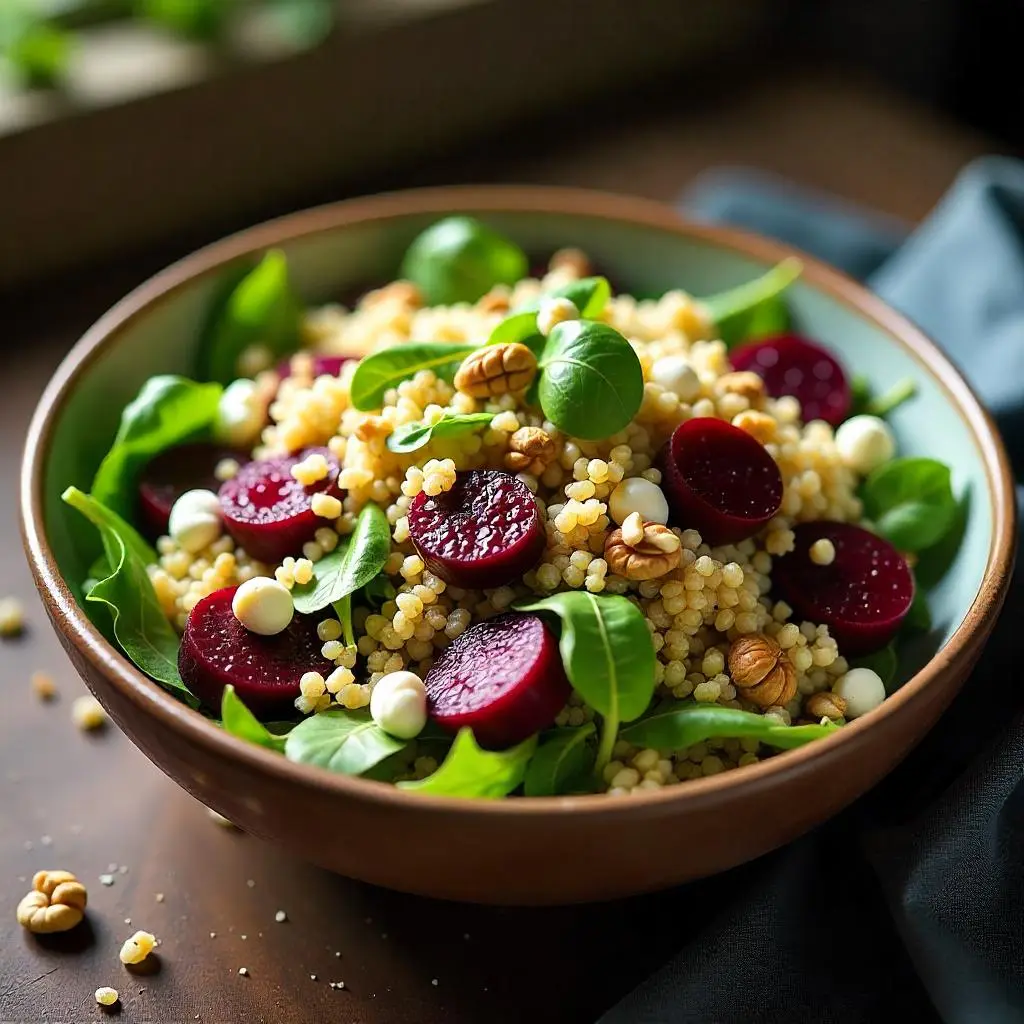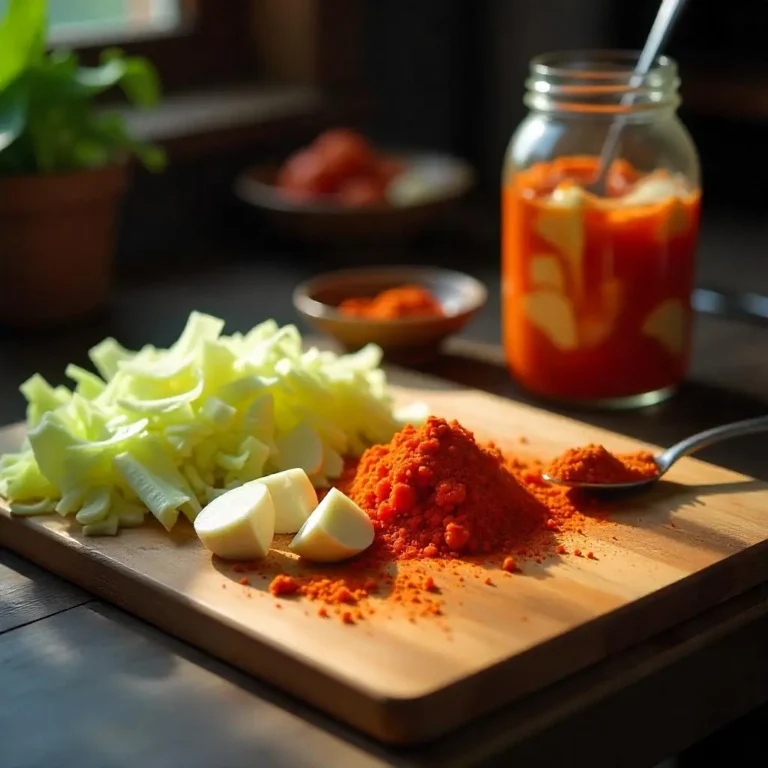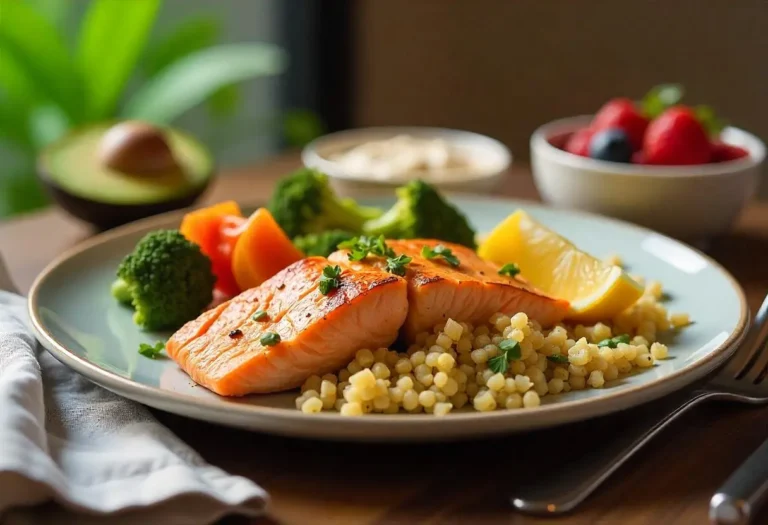Quinoa, Beet, and Arugula Salad
Did you know that a single cup of cooked quinoa has all nine essential amino acids? This makes our quinoa, beet, and arugula salad a top choice for healthy salad recipes. The mix of roasted beets, arugula’s peppery taste, and quinoa’s protein makes it more than just a meal. It’s a feast for the eyes and a celebration of health.
Our superfood salad is a feast for the eyes: red beets and green arugula meet quinoa’s crunch. It’s not just pretty; it’s packed with nutrients. Beets are good for your heart, arugula is full of vitamin C, and quinoa gives you energy. It’s great as a main dish or a side, showing that taste and health can go hand in hand.
Key Takeaways
- Quinoa is one of few plant-based complete proteins, enhancing nutritional value.
- Beets and arugula add bold flavors and vibrant colors, making it a standout colorful salad idea.
- Combines three superfoods into a balanced, nutrient-dense meal for any occasion.
- Easy to adapt for dietary preferences while maintaining rich taste and texture.
- Serves as both a light lunch option and a visually impressive dinner choice.
Introduction to Our Quinoa, Beet, and Arugula Salad
Our nutrient-dense salads mix flavors from around the world. They combine quinoa from the Andes, Mediterranean beet salad benefits, and Italy’s peppery arugula. Let’s see how they come together.
The Origins of This Nutrient-Dense Dish
- Quinoa: A staple of Andean cultures, offering complete protein in every grain.
- Beets: Rooted in Mediterranean diets, celebrated for their earthy sweetness and beet salad benefits.
- Arugula: Brought to tables by Italian cuisine, packed with arugula nutrition like vitamins K and C.
Why This Salad Stands Out From Other Healthy Options
| Ingredient | Nutritional Highlight |
|---|---|
| Quinoa | Complete protein source (8 essential amino acids) |
| Beets | Rich in nitrates and betalains (antioxidants) |
| Arugula | Low-calorie greens with high vitamin density |
What to Expect From This Tutorial
Follow step-by-step guidance on:
- Prepping ingredients for optimal flavor and texture
- Blending quinoa recipes with seasonal produce
- Customizing dressings to enhance beet salad benefits
Discover how to create a dish that’s as nourishing as it is delicious.
Essential Ingredients for the Perfect Salad
Choosing the right ingredients makes your salad full of flavor and good for you. Let’s look at the salad ingredients list step by step.
Begin with quinoa varieties. Try white quinoa for a mild nutty taste, red quinoa for an earthy flavor, or black quinoa for a sweet hint. They’re all gluten-free and high in protein.
For organic beets, pick firm, smooth roots without soft spots. Beet greens are great for salads or sautés, full of vitamins. Choose organic to avoid pesticides.
Fresh arugula brings a peppery kick. Baby arugula is milder, while mature leaves are bolder. Rinse and pat dry to keep them crisp.
Our special dressing includes:
- Extra-virgin olive oil (cold-pressed for freshness)
- Lemon juice or aged balsamic vinegar
- Maple syrup or local honey
- Minced shallots or garlic for depth
Add texture with toasted nuts like walnuts or pine nuts. For creaminess, use feta or goat cheese. Fresh herbs like mint or parsley brighten it up. Adjust to your liking!
Quality is key: go for organic when you can. Swap ingredients wisely, like using cauliflower rice instead of quinoa for less carbs.
Preparing Your Ingredients Like a Professional Chef
Mastering ingredient prep makes your salad stand out. We’ll cover each step with ease and precision.
Cooking Perfect Fluffy Quinoa
Learn how to cook quinoa to perfection. First, rinse the grains well to remove bitterness. Use a 2:1 water-to-quinoa ratio, like 1 cup quinoa to 2 cups water.
Bring the mix to a boil, then lower the heat and simmer for 15 minutes. Let it steam for 5 minutes after. Fluff it with a fork to avoid clumps.
If the quinoa is mushy, use less water next time. If it’s too crunchy, simmer it a bit longer. It should absorb all the water.
Roasting vs. Boiling Beets: Which Method Is Superior
There are two ways to cook your roasted beets techniques. Roasting makes them sweet and flavorful. Wrap whole beets in foil and roast at 400°F (200°C) for 45-60 minutes.
Boiling is quicker (30-40 minutes) but less flavorful. Check if they’re done by poking them with a fork. If it slides in easily, they’re ready.
Peel roasted beets when they cool down. Boiled beets come off their skin when warm. Roasting is better for taste and texture.
Selecting and Preparing Fresh Arugula
Start with fresh, firm arugula leaves. For preparing arugula, soak it in cold water for 5 minutes. This removes dirt.
Drain and spin it dry in a salad spinner. Store it in a damp paper towel in a sealed bag. Tear the leaves for even dressing.
Use baby arugula for a peppery taste or mature leaves for a milder flavor.
Making Our Signature Dressing
Our homemade salad dressing is a mix of tangy and creamy. Mix 3 tbsp olive oil, 1 tbsp apple cider vinegar, 1 tsp Dijon mustard, and ½ tsp honey. Whisk or shake well to mix.
Taste and adjust with salt, pepper, or red wine vinegar. Use it right away or store it in the fridge for up to 3 days. Adjust the dressing to match the sweetness of the beets.
Step-by-Step Assembly of Quinoa, Beet, and Arugula Salad
Learning salad assembly tips makes your dish look and taste great. Start by placing ingredients in a way that looks good and is healthy. Using food presentation techniques turns your salad into a work of art. Layering helps keep everything fresh and adds texture.
Layering Techniques for Visual Appeal
- Begin with quinoa at the bottom—it’s the base.
- Put roasted beets on top in thin slices or chunks. Arrange them to prevent colors from mixing with the greens.
- Finish with arugula, making it stand out. Fan the leaves around the edges for a fresh look.
Perfecting Balanced Flavor Profiles
Start by adding dressing a little at a time and tasting. Adjust the acidity with lemon or balsamic vinegar. This ensures the flavors are balanced without overpowering the greens. Add crunchy nuts or seeds to contrast with the beets.
Final Touches for Maximum Impact
End with a sprinkle of microgreens or edible flowers for color. Drizzle extra-virgin olive oil in a line down the middle. Season from above to spread the salt evenly. This is a pro food presentation technique for perfect seasoning.
Nutritional Benefits and Health Advantages
Our salad is packed with nutrients, thanks to quinoa, beets, and arugula. Each adds something special, like quinoa’s protein and arugula’s vitamins.
- Quinoa protein content: 8g per serving provides all nine essential amino acids, making it ideal for muscle repair and energy.
- Beet antioxidants (betalains) combat oxidative stress, while nitrates improve blood flow and cardiovascular health.
- Arugula health benefits include sulforaphane, a compound linked to cancer prevention, plus vitamin K for bone strength.
| Per Serving | Macronutrients |
|---|---|
| Calories | 350 kcal |
| Protein | 9g (from quinoa and greens) |
| Fiber | 6g (supports digestion) |
| Healthy Fats | 8g (from olive oil in dressing) |
“This combination creates a synergistic effect—vitamin C in arugula enhances iron absorption from quinoa, optimizing nutrient utilization.”
This salad is great for anyone looking for a healthy meal. It has complex carbs, protein, and antioxidants. It’s perfect for workouts or managing weight, offering energy and repair for cells. Studies suggest the beet antioxidants can also boost athletic performance by improving oxygen use during exercise.
Creative Variations to Customize Your Salad
Make your salad your own with these tips. Add seasonal touches, extra protein, or global flavors. Every bowl will be fresh and exciting.
Seasonal Adaptations
Change up your salad with seasonal salad variations. In summer, try juicy peaches or heirloom tomatoes. Autumn brings roasted butternut squash and pomegranate seeds.
Winter salads feature citrus and root vegetables. Spring salads are light with herbs and peas.
Protein Additions
Turn your salad into a protein-rich salad with protein. Grill chicken, sear salmon, or add tofu. Hard-boiled eggs or chickpeas add crunch.
Each protein makes the salad a complete meal.
Dietary Restriction Modifications
Make your salad fit any diet with simple changes. For vegans, use maple syrup in dressings. For gluten-free salad recipes, choose gluten-free tamari soy sauce.
Paleo diets can swap quinoa for roasted sweet potato. Keto diets boost fats with avocado oil and reduce beet portions.
International Flavor Inspirations
Try international salad inspirations for a global twist. Mediterranean salads include Kalamata olives and feta cheese. Asian salads use sesame oil and mandarin segments.
Mexican salads feature toasted pepitas and lime zest. Middle Eastern salads highlight za’atar spice and pomegranate molasses.
Serving Suggestions and Pairing Recommendations
For the best taste, serve your salad at the right temperature. Let it sit for 15–20 minutes after chilling. This makes it cool but still refreshing. Adjust the amount based on the meal: 1 cup for an appetizer, 1.5–2 cups as a side, or 3 cups as a main dish for meal planning with salads.
- Pair with crisp whites like wine with salad staples: Sauvignon Blanc or Pinot Gris.
- Light reds like Pinot Noir or dry rosé enhance the salad’s earthy undertones.
- Try a wheat beer or light IPA for a refreshing beer pairing.
- Sparkling water with citrus or herb-infused iced tea for non-alcoholic options.
- Accompany with grilled salmon, chicken, or tofu for protein-rich meals.
- Offer toasted sourdough or rosemary crostini for texture contrast.
- Pair with roasted Brussels sprouts or roasted carrots for seasonal harmony.
“A crisp acidity in wine highlights the salad’s brightness. Sauvignon Blanc’s citrus notes mirror the arugula’s peppery kick.” — Emily Carter, Culinary Sommelier
For storing, keep ingredients separate. Store quinoa and roasted beets in airtight containers, and keep the dressing aside. Toss everything together 30 minutes before serving to keep it crisp. Serve in wide bowls to show off the colors. This salad is perfect for any time—whether it’s a weeknight dinner or a holiday feast.
Conclusion: Mastering the Vibrant Quinoa, Beet, and Arugula Salad
Adding this recipe to your routine boosts your skills in healthy meal prep. It introduces you to nutritious salad recipes. Techniques like roasting beets or layering textures are useful in many dishes.
This mix of quinoa, beets, and arugula shows how plant-based meals can be both healthy and beautiful. It’s a great example of balanced diet ideas.
Challenges like time or ingredient shortages can happen. Cook quinoa in batches and chop veggies weekly to prep ahead. If you can’t find beets, try carrots or spinach. These small changes keep the recipe flexible while keeping it healthy.
Our suggested variations help you make it your own. Add nuts, seeds, or avocado for extra protein. Try different dressings to match your taste. Each change makes the dish your own without losing its health benefits.
Start with what you can do now. Even a simple version is a step forward. Celebrate every small success in your journey to better eating. Share your changes and watch how this dish evolves with your cooking skills. Every bite is a reminder of your commitment to healthy eating.
FAQ
What are the health benefits of quinoa, beet, and arugula salad?
Our quinoa, beet, and arugula salad is full of good stuff. Quinoa is a complete protein with all nine essential amino acids and lots of fiber. Beets are packed with nutrients that help your heart. Arugula adds vitamins K and A, which are great for your bones and immune system.
How can I customize this salad to fit my dietary needs?
You can make this salad your own. Vegans, use maple syrup instead of honey. For paleo diets, swap quinoa for sweet potatoes. If you’re on keto, add more healthy fats and less beet.
Is it necessary to roast the beets, or can they be boiled instead?
Both roasting and boiling beets work, but roasting is better. It brings out the beets’ natural sweetness and flavor. Boiling is quicker, but roasting is our top choice for taste.
What is the best way to store leftover salad?
Keep leftover salad in an airtight container in the fridge. If storing for more than a few hours, separate the dressing to keep the greens crisp. Enjoy it within 2-3 days for the best taste and texture.
Can I add proteins like chicken or tofu to make it a complete meal?
Yes! Adding proteins like grilled chicken or tofu makes the salad more filling and nutritious. You can also add chickpeas for a plant-based option. This makes the salad versatile for different diets.
What are some beverage pairings that complement this salad?
Pair the salad with crisp white wines like Sauvignon Blanc or light-bodied Pinot Noir. Wheat beer or session IPA are good beer choices. Sparkling water with citrus or iced herbal tea also pair well.
Can I prepare components of the salad ahead of time?
Yes, you can prep parts of the salad ahead. Cooked quinoa and roasted beets can be stored for days. Just wash and dry the arugula before serving. This makes assembling the salad easy.
How do I keep the arugula fresh for longer?
Store arugula in a breathable bag in the fridge’s crisper drawer. Don’t wash it before storing to avoid wilting. If you do wash it, dry it well before refrigerating.
Are there seasonal variations for this salad?
Yes! Try new ingredients with the seasons. Summer is great for stone fruits or berries. Fall is perfect for roasted butternut squash or pomegranate seeds. Each season brings new flavors to enjoy.







